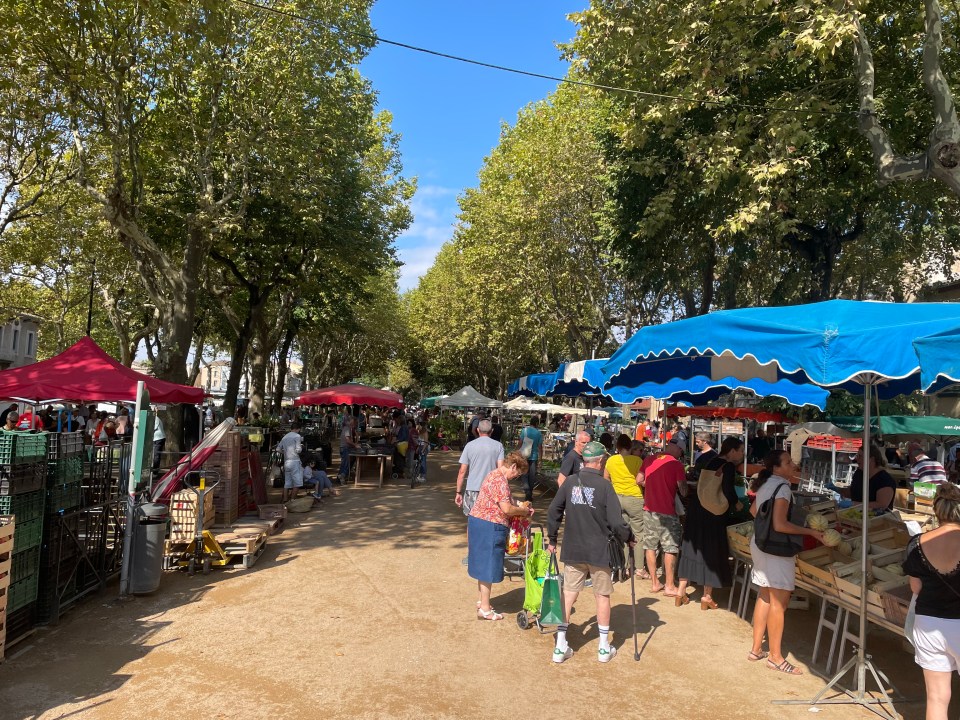A Nation of Shopkeepers
It has to be said: the French, not the English, are a nation of shopkeepers.
Nobody in this town lives on the ground floor. Unlike the castle across the river, which was built for security, this town was built for commerce from the beginning. As in Florence and dozens of other towns that grew wealthy in the middle ages, the people of Carcassonne used their ground floors for keeping their store, stabling, plying their trades, and purveying their wares. They literally lived above their shop.
Wide porte-cochères lead into courtyards, off which grand arches open into workshops and storehouses, while impressive stone staircases take you up to the private dwelling. People lived away from the stench of the street and above their place of business. There, it was secure (look at the size of some of those doors) and airy. It is not much different today. The ground floor is for trade and shopfronts, although nowadays apartments are upstairs, not the private quarters of the tradesman or the business owner.

A popular local shop is Monoprix. Only a short walk from the apartment, it is the Bastide’s only purpose-built department store, erected in 1899, but much modified since then. Unchanged, however, is the statue of the Virgin Mary that still looks down on those who do business here.
It might seem odd for a figure of religious veneration to be on a department store, but there are some other examples around town, too. It might be because of the handiness of such statuary when the convents were demolished after the Revolution and the churches converted to secular use. (For several years the huge nave of St Vincent’s housed a foundry for producing cannon. The canons of St Vincent replaced by the cannons of the republican army.)
I have to say that the prices in this region are good for basic foodstuffs. Eggs are nearly always cage-free (it will soon be the law) and inexpensive, as is bread and most staples.
Mind you, the chocolatier in the main square charges big bucks for a box of chocolates, but they are really good!

Market days, especially Saturdays, are very busy. Everyone loads up for the next two days since most shops do not open again until Tuesday.

I have shopped in the specialty shops, and invariably buy my bread from the local boulangerie, but I do like the self-service aspect of supermarket shopping. (I’m still nervous about speaking French, even though I do it quite well. I just hate to make a mistake.) I bought my pork chops and the closest equivalent I could find to bacon (smoked breast of pork) at the local butcher’s last week and was surprised to see how popular horse meat was. Of the four people in the line in front of me two bought horse meat along with their regular order. It was certainly less expensive than beef, and looked richer and leaner. I was surprised to see it being sold because I thought it had gone out of fashion. When I was working just north of Paris in the sixties, the local town had both a boucherie and a boucherie chevaline, because in those days the same butcher wasn’t permitted to sell both types of meat. As a general rule, French steak is a lot tougher than we are used to in North America. It is grass fed, which makes it leaner and less marbled.
In this part of France duck is extremely popular, although chicken still outsells it. You can buy poulet de Bresse (the very best chicken in the world, so they say) in the market or at the specialty chicken shops and the high-end butchers, but the choice is usually between white or yellow chicken. The difference is in the feed and breed. Maize, or corn, gives a yellow tinge to the flesh, and makes it fatter, but the white chicken is just as nutritious, with less of its fat running off in the cooking. Most seem to think that the yellow birds taste better, just as many people prefer brown eggs.
Locally supplied fresh lamb and pork are also readily available, and rabbit seems very popular.
